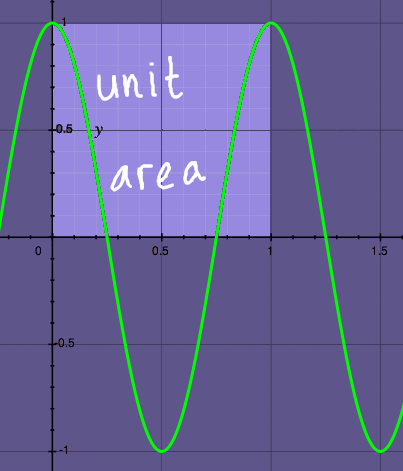
The major feature of sinusoids, making them the jack-of-all-trades
amongst waveforms, is their steady, reliable amplitude. On the matrix
pages I illustrated how to compute vector norms or amplitudes. These
were very small-scale examples with numbers. Now I
want to do pictures with curves.
The amplitude of a signal is similar to the integrated absolute
(unsigned) area
over one period. We are going to find the area of a cosine function
with period one, that is, cos(2*pi*x). A unit area of 1x1 is the
reference:
 |
How is the area of cosine to be computed? It is clear that if the
sample values would be summed, the result over the interval 0-1 would
be zero. Half of the samples is negative-valued, and they would exactly
cancel the positive values. That is why functions like cosine are
defined 'not absolutely integrable'.
 |
We need to find the area in the absolute sense. Like it would be
with the cosine function rectified:
 |
At this point, I want to recall the 'Pythagoras-extended' method of
computing a vector norm or amplitude. Functions like cosine are called
'square-integrable' functions. The method for computing their area is
very similar to computing a vector norm in the discrete case:
 |
To compute the amplitude of a sampled cosine function with period
one would require these steps:
- square all it's sampled values over the interval of one period
- sum the squares; this gives the inner product, the total energy
- divide this sum by the number of samples: this gives the energy
independently of the number of samples, as a portion or fraction
of 1
- take the square root of the energy value: that gives the
amplitude
These steps can be visualized to a certain extent. Below, we see the
cosine function squared. The area under the squared cosine covers half
a unit area.
 |
The inner product, or energy, or norm-squared, of cosine is 0.5. To
compute
the norm or amplitude is now simple: take the square
root of 0.5. It is around 0.707. The norm of a cosine
function over a full period is 0.707, or more precise, the square
root of 0.5.
Below is the figure for sin(2*pi*x) and the square of it. Not
surprisingly, sine has the same amplitude as cosine: 0.707, or more
precisely the square root of 0.5.
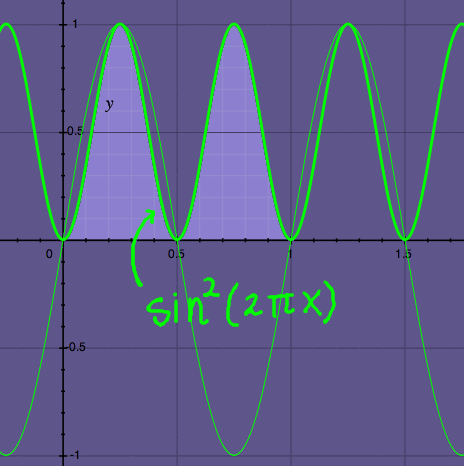 |
I want to know what will happen when the peak-value of cosine is
reduced from 1 to 0.5. So I plot 0.5(cos(2*pi*x) and the square of
that. Inspecting the area under the squared curve, I guess it is
0.125. That is the energy, and the amplitude should be the root of
this: 0.3535. Hey, that is exactly half of 0.707.
 |
Drawing conclusions from one example is dangerous. Here is another
example with 0.8cos(2*pi*x), and the squared curve peaking to 0.64. The
area under the squared curve is 0.32 and the root of that is around
0.566. That must be the amplitude of 0.8*cos. And indeed, 0.8*0.707 is
0.5656.
 |
Although the peak value of cosine is not it's amplitude, a variation
in the peak value is proportional to a variation in the amplitude. That
is handy.
Now I am curious, what will happen when sine and cosine are summed?
I will plot the
sum, and the square of the sum. The area of the
squared sum signal seems to be exactly 1. The combination has unit
energy. And
because the square of 1 is 1, it has unit amplitude as well. From the
picture, the peak-to-peak value of the sum signal can also be
estimated.
It is around 1.4. The precise value would be the square root of two.
 |
Sine and cosine have steady amplitudes. Their combined amplitude is
unity amplitude over the interval [0,1]. But it is also unity when you
look at it pointwise, sample by sample. From the sinusoidal curves it
is
impossible to see this at a glance. Therefore I have
drawn a couple of example points on the curves, and their corresponding
complex exponentials on the unit circle:
 |
 |
Speaking of complex vectors, what about their conjugates, with the
negative imaginary parts? I plotted the summed conjugate vectors with
period one, and their squares. Considering the symmetry of the
conjugates, it would be natural to integrate over a unit interval
centered round zero, so [-0.5, 0.5]. Again, the total area covered is
unity, and
so would be the area of the square root.
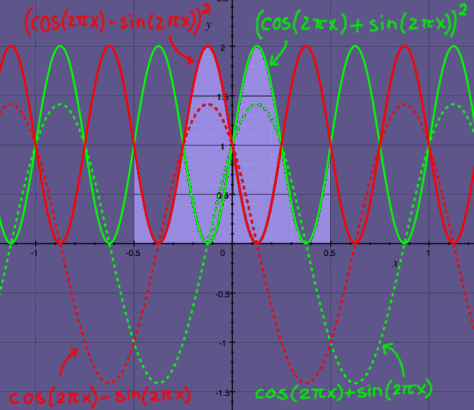 |
There is a couple of special cases for sinusoid amplitudes. The first one is that of cos(0x) and sin(0x). Their 'curves' are shown below; they are perfectly straight lines at y=1 and y=0 respectively. These are functions with infinite period. So strictly speaking, they are not integrable, not even square integrable. Still, it can be argumented that the amplitude of cos(0x) over a unit interval is 1. And the amplitude of sin(0x) over a unit interval is zero. The plot below illustrates this case. In engineering terminology it is known as the direct current or DC case.
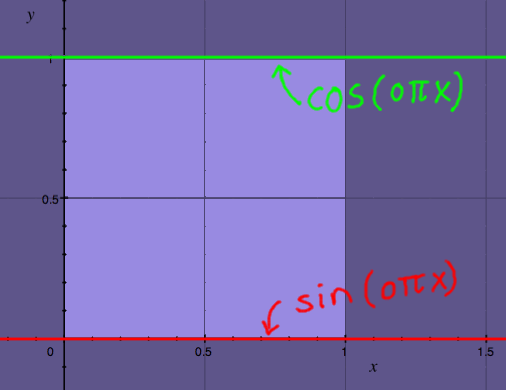 |
The second special case of sinusoid amplitude does not look
sinusoidal either. It is the case of discrete sinusoids at half the
sampling rate of a system. A cosine looks like a square wave under this
condition, because it alternates from peak to peak without inbetween
values. As a square wave, it has amplitude 1. A sine wave can not exist
at half the sampling rate, because it's peaks would fall precisely in
between the sample points. So it has amplitude zero by definition.
 |
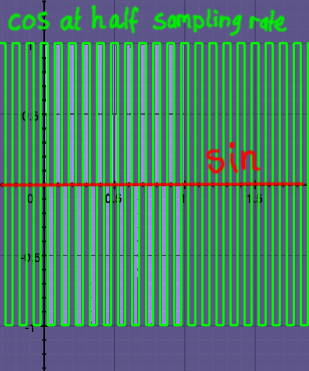 |
The mathematical interpretation of these special cases is: they are
pure real functions, and have no conjugates. They can not have that,
because there is no imaginary part. Or, you could say, they are their
own conjugates. So, a unity DC component could be expressed:
In a matrix with complex conjugate vectors, DC and the
half-sampling-rate vectors are represented with only one vector each.
Much more can be said about sinusoid integrals. On this page, I have summed sine and cosine, and their combined amplitude is unity. On the next page, I will multiply sine and cosine. That will show yet another useful surprise.